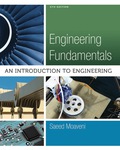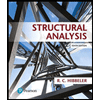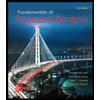
EBK ENGINEERING FUNDAMENTALS: AN INTROD
5th Edition
ISBN: 8220100543401
Author: MOAVENI
Publisher: CENGAGE L
expand_more
expand_more
format_list_bulleted
Question
Chapter 16, Problem 7P
To determine
Draw the top, the front and the right side orthogonal views of the given object and indicate when an object needs only one or two views.
Expert Solution & Answer
Want to see the full answer?
Check out a sample textbook solution
Students have asked these similar questions
Question 6.
Water enters a reach of rectangular channel
where y₁ = 0.5 m, b = 7.5 m, and Q = 20 m³/s
(Figure P10.39). It is desired that a hydraulic
jump occur upstream (location 2) of the sill
and on the sill critical conditions exist (loca-
tion 3). Other than across the jump, losses can
be neglected. Determine the following:
(a) Depths at locations 2 and 3
(b) Required height of the sill, h
(c) Resultant force acting on the sill
(d) Sketch the water surface and energy
grade line.
(e) Describe the nature and character of the
jump.
1
2
3.
h
Question 5. This figure shows a cross section of an aqueduct that carries water at 50 m³/s. The
value of Manning's n is 0.02. Find the bottom slope.
45°
4.0 m
7.0 m-
Question 4. A rectangular, unfinished concrete channel of 30-ft width is laid on a slope of 7 ft/mi.
Determine the flow depth and Froude number of the flow if the flowrate is 350 ft³/s.
Chapter 16 Solutions
EBK ENGINEERING FUNDAMENTALS: AN INTROD
Ch. 16.1 - Prob. 1BYGCh. 16.1 - Prob. 2BYGCh. 16.1 - Prob. 3BYGCh. 16.1 - Prob. 4BYGCh. 16.1 - Prob. BYGVCh. 16.3 - Prob. 1BYGCh. 16.3 - Prob. 2BYGCh. 16.3 - Prob. 3BYGCh. 16.3 - Prob. 4BYGCh. 16.3 - Prob. 5BYG
Ch. 16.3 - Prob. BYGVCh. 16.4 - Prob. 1BYGCh. 16.4 - Prob. 2BYGCh. 16.4 - Give examples of common electrical engineering...Ch. 16.4 - Prob. 4BYGCh. 16.4 - VocabularyState the meaning of the following...Ch. 16 - Prob. 1PCh. 16 - Prob. 2PCh. 16 - Prob. 3PCh. 16 - Prob. 4PCh. 16 - Prob. 5PCh. 16 - Prob. 6PCh. 16 - Prob. 7PCh. 16 - Prob. 8PCh. 16 - Prob. 9PCh. 16 - Prob. 10PCh. 16 - Prob. 11PCh. 16 - Prob. 12PCh. 16 - Prob. 13PCh. 16 - Prob. 14PCh. 16 - Prob. 15PCh. 16 - Prob. 16PCh. 16 - Prob. 17PCh. 16 - Prob. 18PCh. 16 - Prob. 19PCh. 16 - Prob. 20PCh. 16 - Prob. 21PCh. 16 - Prob. 22PCh. 16 - Prob. 23PCh. 16 - Prob. 24PCh. 16 - Prob. 25PCh. 16 - Prob. 26PCh. 16 - Prob. 27PCh. 16 - Prob. 28PCh. 16 - Prob. 29PCh. 16 - Prob. 30PCh. 16 - Prob. 31PCh. 16 - Prob. 32PCh. 16 - Prob. 33PCh. 16 - Prob. 34PCh. 16 - Prob. 35PCh. 16 - Prob. 36PCh. 16 - Prob. 37PCh. 16 - Prob. 38PCh. 16 - Prob. 39PCh. 16 - Prob. 40PCh. 16 - Prob. 41PCh. 16 - Prob. 42PCh. 16 - Prob. 43PCh. 16 - Prob. 44PCh. 16 - Prob. 45PCh. 16 - Prob. 46PCh. 16 - Prob. 47PCh. 16 - Prob. 48PCh. 16 - Prob. 49PCh. 16 - Prob. 50P
Knowledge Booster
Similar questions
- Question 3. A lake discharges into a steep channel. At the channel entrance the lake is 4 m above the channel bottom. Neglecting losses, find the discharge for the following geometries: (a) Rectangular section, b = 4 m (b) Trapezoidal section, b = 3 m, angle = 60° (c) Circular section, d = 3.5 m.arrow_forwardQuestion 7. A popular sharp-crested weir for use in low-flow situations is the V-notch weir, as shown below. When these weirs are designed, the equation for determining the flowrate by neglecting the velocity head of the upstream flow can be written as Q = CH", where C is a coefficient of discharge and is a function of the notch angle (0) and n is a weir constant. The constants C and n must be determined experimentally for a given weir. In logarithmic form, the weir equation is log Q = n log H + log C. Assume we have a flume in the lab where we can experimentally explore the relationship between Q and H for this weir by adjusting the flowrates. Develop an appropriate experiment to determine n and C' (the weir discharge coefficient) for the weir used. Write the experimental procedure steps and measurement readings that are needed to determine these coefficients empirically. Hint: Please refer to your lab manual. Draw down Nappe H V notch weir Weir plate sharp-crested weirarrow_forwardPlease solve the question by hand with a detailed explanation of the steps.arrow_forward
- Please solve the question by hand with a detailed explanation of the steps.arrow_forwardGiven the properties of the wide flange: Property Value d = 530 mm bf = 210 mm tw = 18 mm tf = 16 mm Compute the value of rt defined as the radius of gyration of compression flange plus 1/3 of the compression web area about y-axis.correct answer: (50.52 mm)arrow_forwardUsing a relevant image such as a 3D architectural rendering of a warehouse landscape in Edmond.arrow_forward
- A simple beam has a span of 10 m and supports a total uniformly distributed load of 12 kN/m. Properties of W 480×86: Property Value A = 10800 mm² bf = 180 mm tf = 15 mm Ix = 383.13 × 10⁶ mm⁴ tw = 12 mm d = 480 mm Questions: Calculate the maximum shear in the beam in kN. Calculate the average shear stress in the beam in MPa. Calculate the maximum shear stress in the beam in MPa. Given the properties of the wide flange: Property Value d = 530 mm bf = 210 mm tw = 18 mm tf = 16 mm Question: Compute the value of rₜ, defined as the radius of gyration of the compression flange plus 1/3 of the compression web area about the y-axis.arrow_forwardGiven an existing two-story steel structure with interior columns spaced as shown in Fig.2. The columns are spaced at 18 ft in the North-South direction and at 30 ft in the East-West direction. An interior lower-story column is to be removed by adding newsteel girder as shown in Fig. 4. The floor dead loads and the roof dead loads are 70 psfand 18 psf respectively. The floor live loads and the roof live loads are 50 psf and20 psf respectively. All existing steel materials are ASTM A36 steel (Fy=36 ksi). Newgirder is ASTM A992 steel (Fy= 50 ksi). All columns are W8x31. Use the LRFD Method.Assumptions:1- The loads given include column and beam self weights.2- Existing beam and new girder are simply supported at both ends.3- New girder top flange is laterally braced at mid span and at girder ends only.4- Columns are continuous from foundation to roof and are prevented from sway atfloor level and at roof level in both directions.5- Columns are pin supported at foundation, at floor level,…arrow_forwardFindarrow_forward
- Determine the vertical reaction at A for the beam shown and a settlement of ½" at support B. a. 45.6 k b. 41.6 k c. 42.7 k d. 40.7 karrow_forwardWhat is the horizontal reaction at A for the frame shown 4? a. 2.42 k b. 15.00 k c. 27.58 k d. 25.00 karrow_forwardDetermine the bending moment at support A for the beam shown using the slope-deflection method. Use the sign convention defined in the chapter. a. 232.9 k-ft b. -182.1 k-ft c. 182.1 k-ft d. -232.9 k-ftarrow_forward
arrow_back_ios
SEE MORE QUESTIONS
arrow_forward_ios
Recommended textbooks for you

 Structural Analysis (10th Edition)Civil EngineeringISBN:9780134610672Author:Russell C. HibbelerPublisher:PEARSON
Structural Analysis (10th Edition)Civil EngineeringISBN:9780134610672Author:Russell C. HibbelerPublisher:PEARSON Principles of Foundation Engineering (MindTap Cou...Civil EngineeringISBN:9781337705028Author:Braja M. Das, Nagaratnam SivakuganPublisher:Cengage Learning
Principles of Foundation Engineering (MindTap Cou...Civil EngineeringISBN:9781337705028Author:Braja M. Das, Nagaratnam SivakuganPublisher:Cengage Learning Fundamentals of Structural AnalysisCivil EngineeringISBN:9780073398006Author:Kenneth M. Leet Emeritus, Chia-Ming Uang, Joel LanningPublisher:McGraw-Hill Education
Fundamentals of Structural AnalysisCivil EngineeringISBN:9780073398006Author:Kenneth M. Leet Emeritus, Chia-Ming Uang, Joel LanningPublisher:McGraw-Hill Education
 Traffic and Highway EngineeringCivil EngineeringISBN:9781305156241Author:Garber, Nicholas J.Publisher:Cengage Learning
Traffic and Highway EngineeringCivil EngineeringISBN:9781305156241Author:Garber, Nicholas J.Publisher:Cengage Learning


Structural Analysis (10th Edition)
Civil Engineering
ISBN:9780134610672
Author:Russell C. Hibbeler
Publisher:PEARSON

Principles of Foundation Engineering (MindTap Cou...
Civil Engineering
ISBN:9781337705028
Author:Braja M. Das, Nagaratnam Sivakugan
Publisher:Cengage Learning

Fundamentals of Structural Analysis
Civil Engineering
ISBN:9780073398006
Author:Kenneth M. Leet Emeritus, Chia-Ming Uang, Joel Lanning
Publisher:McGraw-Hill Education


Traffic and Highway Engineering
Civil Engineering
ISBN:9781305156241
Author:Garber, Nicholas J.
Publisher:Cengage Learning